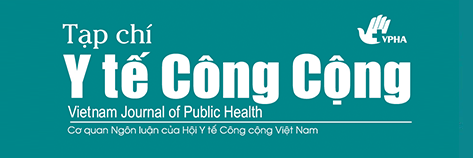Tác động dài hạn của bụi mịn Pm2.5 đến số ca tử vong chung tại TP.HCM năm 2018 - 10.53522/ytcc.vi55.210415
Tóm tắt
Thông tin chung: Ô nhiễm không khí là một yếu tố nguy cơ đối với các bệnh không lây với ước tính gây ra 7 triệu người chết mỗi năm1. Nồng độ bụi trung bình 24 giờ tại Tp.HCM qua các năm từ 2013 đến 2017 đều vượt mức tiêu chuẩn cho phép của WHO.
Phương pháp: Nghiên cứu xây dựng bản đồ PM2.5 và đánh giá tác động sức khỏe dài hạn của ô nhiễm bụi PM2.5 đến gánh nặng tử vong tại Tp.HCM năm 2018. Thiết kế nghiên cứu đánh giá tác động sức khỏe, sử dụng dữ liệu đa nguồn bao gồm dữ liệu hồi cứu tử vong A6/YTCS; dữ liệu địa lý, dân số và quan trắc thực địa môi trường có sử dụng thiết bị cảm biến chi phí thấp AirBeam2.
Kết quả: 29.176 ca tử vong tại Tp.HCM do tất cả các nguyên nhân được đưa vào nghiên cứu trong đó PM2.5 được cho là có tác động dài hạn đến 1.770 ca tử vong. Nhóm nghiên cứu nhận thấy, khi tăng nồng độ PM2.5 lên 1mg/m3 thì số ca sử vong do tất cả nguyên nhân tăng 45 người.
Kết luận: Tác động dài hạn của PM2.5 tại Tp. HCM là đáng kể. Cần áp dụng các biện pháp phòng ngừa phù hợp để bảo vệ sức khỏe người dân và giảm thiểu gánh nặng tử vong do tác động dài hạn của PM2.5 gây ra.Từ khóa
Toàn văn:
PDF##submission.citations##
WHO. How air pollution is destroying our health. 2018; https://www.who.int/air-pollution/news-and-events/how-air-pollution-is-destroying-our-health. Accessed accessed on 12/29/2018.
WHO. 9 out of 10 people worldwide breathe polluted air, but more countries are taking action. 2018; http://www.who.int/news-room/detail/02-05-2018-9-out-of-10-people-worldwide-breathe-polluted-air-but-more-countries-are-taking-action. Accessed accessed on 11/14/2018.
WHO. WHO Global Ambient Air Quality Database (update 2018). 2018; https://www.who.int/airpollution/data/cities/en/. Accessed accessed on 12/30/2018.
WHO. More than 90% of the world’s children breathe toxic air every day. 2018; https://www.who.int/news-room/detail/29-10-2018-more-than-90-of-the-world%E2%80%99s-children-breathe-toxic-air-every-day. Accessed accessed on 12/29/2018.
Song C, He J, Wu L, et al. Health burden attributable to ambient PM2.5 in China. Environmental Pollution. 2017;223:575-586.
Metrics IfH, Project EsGBoD, Institute THE. The State of Global Air. 2018.
AirVisual. World most polluted countries 2018 (PM2.5) 2018; https://www.airvisual.com/world-most-polluted-countries. Accessed 10th November, 2019.
Environmental Protection Agency. Guidance on Choosing a Sampling Design for Environmental Data Collection: for Use in Developing a Quality Assurance Project Plan. 2002.
Li L, Losser T, Yorke C, Piltner R. Fast Inverse Distance Weighting-Based Spatiotemporal Interpolation: A Web-Based Application of Interpolating Daily Fine Particulate Matter PM2.5 in the Contiguous U.S. Using Parallel Programming and k-d Tree. Environmental Research and Public Health. 2014;11:9101-9141.
Setianto A, Triandini T. Comparison of Kriging and Inverse Distance Weighted (IDW) interpolation methods in lineament extraction and analysis. Journal of Applied Geology. 2013;5(1):21-29.
Orru H, Erik Teinemaa TL, Tamm T, Kaasik M, Kimmel V, al e. Health impact assessment of particulate pollution in Tallinn using fine spatial resolution and modeling techniques. Environmental Health Perspectives. 2009;8:7.
Michael H, Chris Chaeha Lim. AirBeam2 Technical Specifications, Operation & Performance. 2018; http://www.takingspace.org/airbeam2-technical-specifications-operation-performance/. Accessed access on June 1st 2019.
Feinberg S, Williams R, Hagler GSW, et al. Long-term evaluation of air sensor technology under ambient conditions in Denver, Colorado. Atmospheric Measurement Techniques. 2018;11(8):4605-4615.
Zhang P, Shen T. Comparison of different spatial interpolation methods for atmospheric pollutant PM2.5 by using GIS and Spearman correlation. Journal of Chemical and Pharmaceutical Research. 2015;7(12):452-469.
Chen T, Deng S, Li M. Spatial Patterns of Satellite-Retrieved PM2.5 and Long-Term Exposure Assessment of China from 1998 to 2016. Int J Environ Res Public Health. 2018;15(12).
Boldo E, Medina S, LeTertre A, et al. Apheis: Health impact assessment of long-term exposure to PM(2.5) in 23 European cities. Eur J Epidemiol. 2006;21(6):449-458.
Abe KC, Miraglia SG. Health Impact Assessment of Air Pollution in Sao Paulo, Brazil. Int J Environ Res Public Health. 2016;13(7):694.
Le LTP, Leung A. Associations between urban road-traffic emissions, health risks, and socioeconomic status in Ho Chi Minh City, Vietnam: a cross-sectional study. The Lancet. 2018;2:5.
Ho Quoc Bang. Modeling PM10 in Ho Chi Minh City, Vietnam and evaluation of its impact on human health. Sustainable Environment Research. 2017;27(2):95-102.



